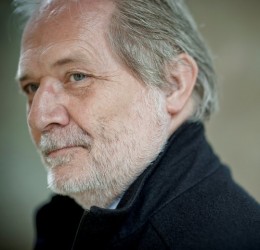 United Kingdom Schoenberg, Bartók, Stravinsky and Eötvös: Iveta Apkalna (organ), László Fassang (Hammond organ), Philharmonia Orchestra / Peter Eötvös (conductor), Royal Festival Hall, Southbank Centre, London, 8.2.2019. (AS)
United Kingdom Schoenberg, Bartók, Stravinsky and Eötvös: Iveta Apkalna (organ), László Fassang (Hammond organ), Philharmonia Orchestra / Peter Eötvös (conductor), Royal Festival Hall, Southbank Centre, London, 8.2.2019. (AS)

Schoenberg – Accompaniment to a Film Scene, Op.34
Bartók – Dance Suite
Stravinsky -Symphony in Three Movements
Eötvös – Multiversum (first UK performance)
If you are going to hear a contemporary piece of music for the first time, it seems right and proper that you should read about it beforehand. That is surely what the composer would want you to do. But should your preparations go to the extent of actually listening to a recording of it in advance? Each to his own, I suppose, but rightly or wrongly I feel that a critic probably should not do this. It is only in recent times that it has been possible, anyway. Great composers of the past were writing for live audiences only, and they had to get their works across to their listeners on the wing, so to speak, before the sounds disappeared into the ether for ever. No sonic preparation was possible. So one wonders if this still applies – that composers still write so that their creations can be understood and appreciated at a single hearing.
These musings were provoked by a communication from a musician contact in which he expressed a very positive reaction after hearing the premiere UK performance of Eötvös’s Multiversum (as noted in the above heading). My own reaction (and that of my guest, to be fair) was much more negative, so should I have listened to and watched a complete previous performance from Frankfurt, freely available on YouTube for all to see? Should I have watched it two or three times, so that repetition would bring points of familiarity to the surface; and would this have made me feel better or worse about the work? Was the reaction of the contact just that of somebody who was different and who heard the piece differently (everybody hears things individually, of course – we all have unique brain structures). Would the composer wish pre-performance study to be undertaken, or would he prefer that his work was heard fresh, without preparation, against a blank visual canvas? Well, I cannot answer these questions, of course, but can only report my reaction to a single live hearing, for better or worse.
In Multiversum Eötvös is literally aiming for the stars in seeking, as the programme note explained, ‘to create a sound world that envelops the listener in the same way that the universe envelops the world’. This intention reflects ‘the composer’s fascination with string theory, gravitational waves and the relationship between multiple universes’. He’s set himself quite a challenge, therefore. And it is one that he seeks to bring to fruition through the use of the contemporary composer’s conventional armoury – a largish ensemble, with orchestral sections separated to provide spatial effects, a battery of percussion instruments, an organ with many and various stops pulled out, and a novelty intruder – in this case an electric Hammond organ. There are three movements, ‘Expansion’, ‘Multiversum’ and ‘Time and Space’.
Without doubt Eötvös is a master of the orchestra and he creates some remarkable sonic effects and some very intriguing sonorities. He uses combinations of rhythm in a very clever fashion; and you certainly don’t have a clue as to what will happen next. This quality of unexpectedness keeps the music interesting throughout its progress, and it has lots of vitality and energy. But none of the movements have any clear shape or contain components that come together and have a unifying purpose. Everything is a sequence of unrelated episodes. There is nothing new in the work. We have heard it all many times before, or things very much like it. Varèse was composing similar music, and to much more individual and striking effect, 90 years ago.
The first part of the concert contained three works, each by an acknowledged giant of the twentieth century – Schoenberg, Stravinsky and Bartók. How splendid it was to hear the first movement of the Symphony in Three Movements taken at the tempo that Stravinsky prescribed in his first, 1946 recording of the work. It should sound as it did on this occasion, weighty, unwieldy and menacing. Nowadays we usually get a more rushed performance of this part of the work, superficially more exciting, but more lightweight in character. Here the more relaxed, elegant, almost lyrical central movement made much more of an effective contrast to what had gone before and what came after in the shape of a fairly fast, vehement account of the final movement.
Bartók’s Dance Suite was played in an unusually soft-grained fashion, with its graceful elements brought out strongly and less vigour and energy than one normally hears in the faster dances. If some of the excitement generated in other performances was missing, one could argue that Eötvös’s approach was completely viable, since the work is a joyous celebration of the 50th anniversary, in 1923, of the unified city of Budapest, not a work of Bartókian violence, as was sometimes the composer’s wont.
The concert began with a great rarity, Schoenberg’s Accompaniment to a Film Scene. Perhaps it is the somewhat strange title that is off-putting, and that is a pity, since although the work dates from the composer’s mature serial period, it is more approachable than some of his other scores that employ this technique. It is surely a brief masterpiece, and the music mirrors its three sections, entitled ‘Threatening Danger’, ‘Fear’ and ‘Catastrophe’ in a wonderfully explicit fashion. Eötvös gave an ideal performance of the work – clear, expressive and highly dramatic – and as in the rest of the concert he was supported by superb orchestral playing.
Alan Sanders
